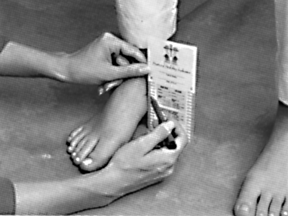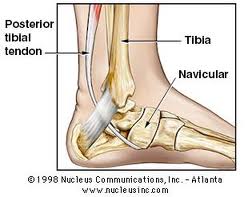 Do you suspect you’re knock-kneed? That is you overpronate (your ankles tilt inward too much) when you walk, causing your arches to flatten? Or, do you think you’re bow-legged? In other words, you oversupinate (your ankles tilt outward too much) when you walk, resulting in a high instep?
Do you suspect you’re knock-kneed? That is you overpronate (your ankles tilt inward too much) when you walk, causing your arches to flatten? Or, do you think you’re bow-legged? In other words, you oversupinate (your ankles tilt outward too much) when you walk, resulting in a high instep?
If so, you should definitely have your feet and gait evaluated by a certified professional. One test that he/she may perform to determine if your medial longitudinal arch is collapsing or not is the navicular drop test.
The navicular bone is a tarsal bone located on the inside of your foot. This test is used to measure the distance between the height of the navicular bone from the floor when you’re in a seated position and when you’re standing in a relaxed position.
This test involves two steps:
- You will be asked to sit comfortably with your feet on the floor – not bearing any weight on your feet. Your foot specialist will feel the inside of your foot to find the navicular prominence, which is located below and in front of the medial malleolus (the prominent bone on the inside of your ankle, formed by the lower end of the tibia bone). The specialist will mark your skin with a pen at the navicular prominence. Then, the specialist will place an index card, standing up, next to the inside of your foot and mark the level of the navicular prominence on the card.
- You will be asked to stand in a relaxed position. Once your arch is bearing weight, the navicular prominence will be lower. The specialist will place the index card next to the inside of your foot and mark this new level of the navicular prominence on the card.
The foot specialist will repeat this two-step process on your other foot. Once the second foot is done, the specialist will measure the difference between the two marks for each foot. If there is a difference of 4 mm or more between the marks on the card, or the specialist notices an obvious difference from your left to right foot, then you suffer from hyperpronation or collapse of the medial arch.
If you overpronate, the arches of your feet will flatten, causing your foot to physically drop downward toward the floor. As your foot drops, your ankle becomes stressed, causing your leg bones (tibia and femur) to rotate inward excessively. This inward rotation of the leg bones also pulls the femur sideways. This, in turn, causes your pelvis to tilt backward, putting stress on your spine all the way up to your head. This abnormal twisting of your body can cause pain in your knees, hips or back.
Therefore, it’s important to realize that your feet provide the foundation for the rest of your body. If your arches aren’t supported in one or both of your feet, you will experience negative effects to your body over time.
ezWalker® Performance Insoles Provide Support for Collapsed Arches
If a foot specialist determines you suffer from flatten arches due to overpronation, custom orthotic devices, like ezWalker® Performance Insoles, can strategically lift the navicular prominence – raising the medial, lateral and trans-metatarsal arches of your feet. Since you’ll have proper biomechanical support of your arches, your body will stay in proper alignment from your feet to your head – with no abnormal twisting or stress on your spine.
Since the introduction of ezWalker® Insoles in 2008, many people have reported improved foot health. Most people experience improvement in about a year – although some individuals have seen improvement in as little as 6 months. Therefore, continued use of ezWalker® insoles will enhance your gait and relieve pain to your feet, knees, hips and/or lower back due to abnormal strain.
For more information on how ezWalker Performance Insoles can improve your foot mechanics, contact us today. To order your ezWalkers today, visit our online shop.
Because … when your feet feel good, you feel good.

